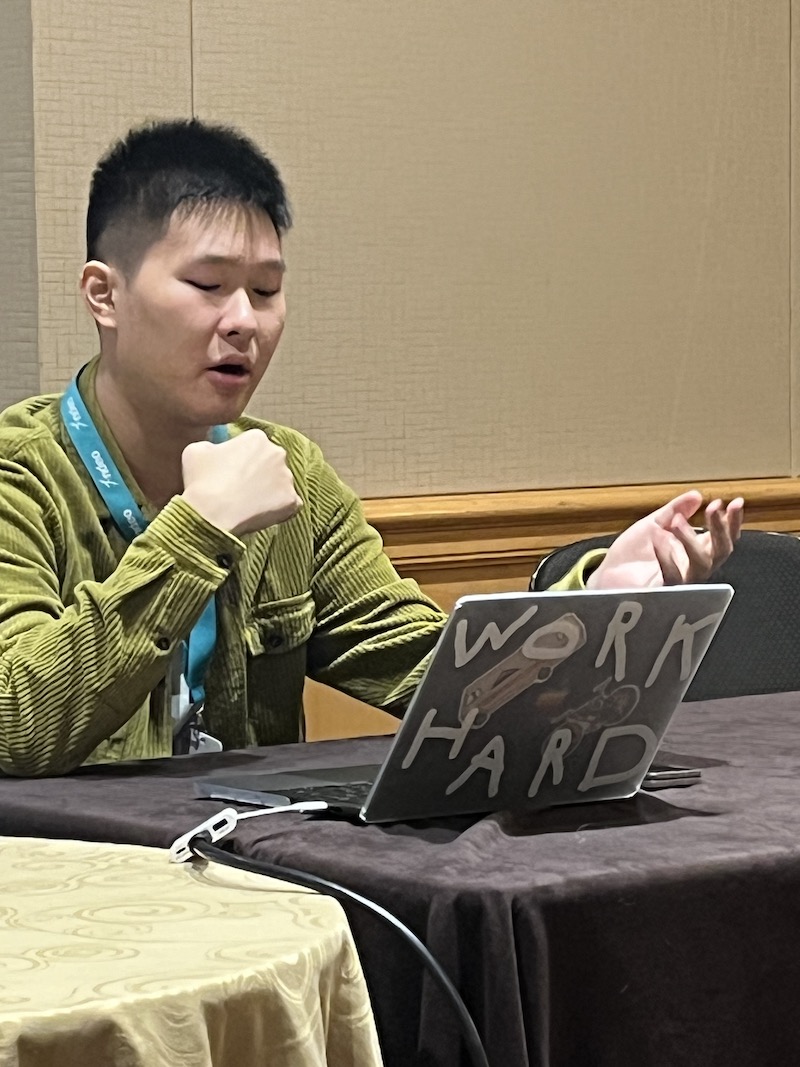


Data and dance
Photo illustration by Jeffrey C. Chase | Photos courtesy of Monica Frichtel April 30, 2025
Blue Hen alumnus Wenhan Ying invents new software to help cut a rug
It’s not often that programming and pirouetting factor into the same conversation, but, as it turns out, they’re not that far removed.
“Computer science and dance are both forms of communication,” said Wenhan Ying, a University of Delaware alumnus. “Whether you’re coding at a desk or moving your body in a studio, you’re expressing yourself.”
Few people are better suited to discuss the server-samba intersection than Ying. The Blue Hen has developed a first-of-its-kind software program (name still in the works) set to help dancers of all genres hone their skills from a ballroom or living room — no fancy mirror or barre required.
It all started in 2020 with the onset of the Covid-19 pandemic. At the time, Ying was a first-year undergraduate student at UD majoring in computer science. Stuck inside during quarantine, he longed for a way to maintain his health and combat the dreaded Covid anxiety. So he made an unexpected choice. With absolutely zero training, he threw himself into the dance minor at UD, which held Zoom classes until it was safe to meet in person.

Given Ying’s wheelhouse at the time was more about algorithms than arabesques, the decision may read as … wild. But Ying has never shied away from gutsy moves — as an international student, he’d recently relocated alone to the U.S. from China. And, he knew, UD is the type of place that supports interdisciplinary exploration.
“It’s one of our great joys in the department,” said Monica Frichtel, Ying’s mentor and an assistant professor of dance. “Inviting students to discover new ways of being — experiencing or creating — in the world feels really important.”
But passion and drive can only take a new dancer so far. Ying found himself struggling to keep up in his courses, which ranged from ballet to ballroom to modern.
“Instructors were so patient with me, and they would meet me for 30 minutes before the start of class for extra practice,” he said. “But I thought to myself: ‘I wonder if there’s a different way.’”
As part of a capstone project for the minor, Ying applied his computer know-how to his dance dilemma. With the help of yet another mentor, professor Matthew Saponaro of the computer and information sciences department, he got to work coding, debugging and testing a new application using dynamic movement recognition technology, a form of artificial intelligence.
Here’s how it works: A user uploads a video of a dance — either a professional clip found online or, for new choreography, a clip taken of more advanced peers. Then, once that user records his or her own attempt at the same dance, the app compares the two performances, and it assigns the user a score from 0 to 100 based on technical proficiency. A play-back option allows for rewatching oneself and identifying any errors.
The project received approval from the Institutional Review Board, a federal agency under the purview of the FDA, meaning Ying received a greenlight to recruit testers, incorporate their feedback and, if all goes to plan, publish his findings in the near future. He also presented his project at the National Dance Education Organization conference in Seattle last year, where he met thought leaders in the field.
“Working on this has not only led to a new lifestyle for me,” he said. “It’s afforded me a whole new community.”

Particularly meaningful connections made with students and educators from New York University recently led Ying to the big apple for three months, where he interviewed the school’s dancers and observed their daily practice in order to better refine his app. He hopes the technology will soon be embraced not just by amateur performers but also instructors, whose rehearsal times have traditionally been dictated by studio hours.
“I think dancers are sometimes quick to reject new technology, understanding that dance depends on humans being together and sharing in experiences,” Frichtel said. “And yet, I do think we need to be open to new ideas in order to grow as a field.”
In the coming years, Ying hopes to make public this technology, which he’s continuing to develop as part of a graduate program at Johns Hopkins University. He’s also exploring other applications outside of dance, from swimming to running and beyond. It won’t be easy, but, he said, he has plenty of supporters on whom he can lean: “It’s difficult for me to express how thankful I am for the warm-hearted mentors I found at UD.”
In the meantime, Ying continues to step outside of his comfort zone every chance he gets. Currently, he’s focusing his own rehearsal time on “creative,” a type of contemporary dance that is less about following technique and more about, well, something that suits Ying just fine:
“This,” he said, “is dancing from the heart.”
Contact Us
Have a UDaily story idea?
Contact us at ocm@udel.edu
Members of the press
Contact us at mediarelations@udel.edu or visit the Media Relations website

